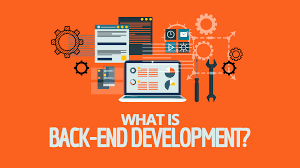info@gladsme.in
+91.8891968718
The Ultimate Guide to Back End Development: Everything You Need to Know
The Ultimate Guide to Back End Development: Everything You Need to Know

The Ultimate Guide to Back End Development: Everything You Need to Know
Back end development is a crucial part of web development that powers the functionality, performance, and scalability of websites and applications. While front end development deals with the visual aspects that users interact with, back end development ensures that everything runs smoothly behind the scenes. In this guide, we'll dive deep into the essentials of back end development, including its core components, popular languages, frameworks, and best practices.
What is Back End Development?
Back end development refers to the server-side part of web development. It involves the creation and management of the core computational logic of websites, applications, and services. The back end is responsible for database interactions, user authentication, server, network, and hosting configurations, as well as business logic.
Core Components of Back End Development
Server: The server is a computer that receives requests from the client-side (front end), processes them, and sends back the appropriate responses. Servers can be physical machines or virtual instances in the cloud.
Database: Databases store and manage data. Back end developers work with databases to perform CRUD (Create, Read, Update, Delete) operations. Popular databases include MySQL, PostgreSQL, MongoDB, and SQLite.
APIs: Application Programming Interfaces (APIs) allow the front end and back end to communicate. APIs define the methods and data formats that applications use to interact with each other.
Server-Side Programming Languages: These languages are used to write the code that runs on the server. Common languages include:
Python: Known for its simplicity and readability, Python is popular for back end development frameworks like Django and Flask.
JavaScript (Node.js): Node.js allows JavaScript to be used for server-side scripting, enabling a unified language for both front end and back end development.
Ruby: Ruby, along with its framework Ruby on Rails, is known for its convention over configuration philosophy.
PHP: A widely-used language, especially in conjunction with content management systems like WordPress.
Popular Back End Frameworks
Frameworks provide pre-built components and tools that simplify and speed up development. Some popular back end frameworks include:
Django (Python): A high-level framework that encourages rapid development and clean, pragmatic design.
Express (Node.js): A minimal and flexible Node.js web application framework.
Ruby on Rails (Ruby): Known for its ease of use and convention over configuration approach.
Laravel (PHP): A PHP framework that provides a robust set of tools and an elegant syntax.
Best Practices in Back End Development
Write Clean, Maintainable Code: Follow coding standards and best practices to ensure your code is readable and maintainable.
Security: Implement robust security measures to protect your application from threats like SQL injection, cross-site scripting (XSS), and cross-site request forgery (CSRF).
Performance Optimization: Optimize your code and database queries for performance. Use caching where appropriate to reduce load times.
Scalability: Design your application to handle growth. This includes using load balancers, scalable database solutions, and microservices architecture.
Testing: Implement thorough testing strategies, including unit tests, integration tests, and end-to-end tests, to ensure your application is robust and reliable.
Documentation: Maintain comprehensive documentation for your code, APIs, and any third-party integrations.
Back end development is the backbone of any robust web application. By understanding its core components, choosing the right tools and frameworks, and following best practices, you can build secure, scalable, and high-performing applications. Whether you’re a seasoned developer or just starting, mastering back end development is a key step in your journey to becoming a well-rounded web developer.
Related Blogs

The Importance of Data Structures in Software Development
Read More...
Exploring Machine Learning Algorithms: A Beginner's Guide
Read More...
The Evolution of Programming Languages: From Assembly to Rust
Read More...
Understanding Big O Notation: A Guide for Developers
Read More...Subscribe for our Newsletter
Subscribe to elevate your software game! Stay updated on the latest trends, coding insights, and exclusive promotions with our newsletter.
